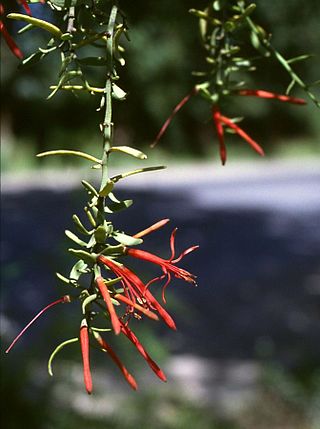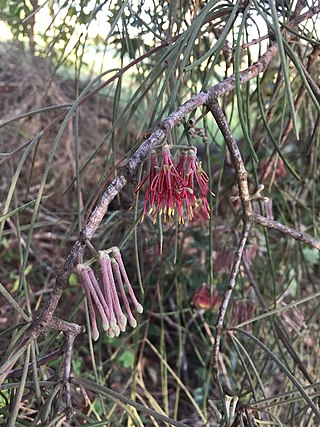
Loranthaceae, commonly known as the showy mistletoes, is a family of flowering plants. It consists of about 75 genera and 1,000 species of woody plants, many of them hemiparasites. The three terrestrial species are Nuytsia floribunda, Atkinsonia ligustrina, and Gaiadendron punctatum Loranthaceae are primarily xylem parasites, but their haustoria may sometimes tap the phloem, while Tristerix aphyllus is almost holoparasitic. For a more complete description of the Australian Loranthaceae, see Flora of Australia onlineArchived 2018-04-01 at the Wayback Machine., for the Malesian Loranthaceae see Flora of Malesia.

Amyema is a genus of semi-parasitic shrubs (mistletoes) which occur in Malesia and Australia.

Lysiana is a genus of hemiparasitic shrubs endemic to Australia, in the family Loranthaceae.

Amyema quandang is a species of hemi-parasitic shrub which is widespread throughout the mainland of Australia, especially arid inland regions, sometimes referred to as the grey mistletoe.

Dendrophthoe glabrescens, commonly known as smooth mistletoe or orange mistletoe, is a hemiparasitic plant of the mistletoe family Loranthaceae, found in eastern and northern Australia. It flowers from October to January. The flowers are tubular, with a green base, but where the tube splits open, it displays orange and bright red.

Amyema benthamii, commonly known as the twin-leaved mistletoe or Bentham's mistletoe, is a species of flowering plant, an epiphytic hemiparasitic plant of the family Loranthaceae native to Western Australia and the Northern Territory of Australia in semi-arid woodland. This species is named in honour of the English botanist George Bentham who between 1863 and 1878 published Flora Australiensis, the first flora of Australia.

Lysiana exocarpi, commonly known as harlequin mistletoe, is a species of hemiparasitic shrub, endemic to Australia. It is in the Gondwanan family Loranthaceae and is probably the most derived genus of that family with 12 pairs of chromosomes. The Loranthaceae is the most diverse family in the mistletoe group with over 900 species worldwide and including the best known species in Australia. Mistletoes are notable for their relationships with other species. In an early reference to the group in Australia Allan Cunningham explorer and first Director of the Royal Botanic Gardens, Sydney, wrote in 1817: "The Bastard Box is frequently much encumbered with the twining adhering Loranthus aurantiacus which 'Scorning the soil, aloft she springs, Shakes her red plumes and claps her golden wings'."

Amyema bifurcata is an epiphytic, flowering, hemiparasitic plant of the family Loranthaceae native to Australia and found in Western Australia, the Northern Territory, Queensland and New South Wales.

Amyema maidenii is a species of flowering plant within the genus Amyema, an epiphytic hemiparasitic plant of the family Loranthaceae native to Australia and found Australia-wide in the inland.

Amyema fitzgeraldii, the pincushion mistletoe, is a species of flowering plant within the genus Amyema, an epiphytic hemiparasitic plant of the family Loranthaceae endemic to Australia, and found in the Northern Territory, South Australia and Western Australia.

Amyema biniflora, the twin-flower mistletoe, is a species of flowering plant within the genus Amyema, an epiphytic hemiparasitic plant of the family Loranthaceae endemic to Queensland, Australia.

Amyema sanguinea is an aerial hemiparasitic shrub within the genus Amyema, in the family Loranthaceae and native to Australia, where it is found in New South Wales, Queensland, the Northern Territory, South Australia and Western Australia.

Amyema gibberula is an aerial hemiparasitic plant of the family Loranthaceae native to Australia and found in Western Australia, the Northern Territory, and South Australia.

Amyema melaleucae, also known as the tea-tree mistletoe, is a species of flowering plant within the genus Amyema, an epiphytic hemiparasitic plant of the family Loranthaceae native to Australia and found in Western Australia and South Australia on the coast, from north of Perth almost to the Victorian border.

Lysiana murrayi is an erect or spreading hemi-parasitic shrub in the Loranthaceae which occurs in all mainland states of Australia except Victoria. It has flat narrow leaves. The leaves are 2.5–6 cm long, 1–3.5 mm wide, do not have a distinct petiole, and the venation is not visible. The inflorescence is a solitary flower or pair of flowers without a common peduncle. The pedicels are 8–20 mm long, and strongly winged towards the apex. The spreading, membranous bracts are 2–3 mm long, and rounded at the apex. The corolla of the mature bud is usually 18–28 mm long, and white, yellow or pink. The fruit is globose, 7–12 mm long, and pink or red.

Muellerina myrtifolia, common name myrtle-leaved mistletoe, is a hemiparasitic aerial shrub in the family Loranthaceae. The species is endemic to New South Wales and Queensland.

Muellerina celastroides, common names Banksia mistletoe and coast mistletoe, is a hemiparasitic aerial shrub in the family Loranthaceae. The species is endemic to New South Wales, Victoria and Queensland.

Amyema cambagei, commonly known as sheoak mistletoe, is a species of flowering plant, an epiphytic hemiparasitic plant of the family Loranthaceae endemic to Australia, and found in New South Wales and Queensland in sclerophyll forest and woodland on several species of Casuarinaceae.

Amyema plicatula is a species of hemi-parasitic shrub found in the Bismarck Archipelago, New Guinea, New South Wales and Queensland.
Amyema thalassia is a species of mistletoe in the family Loranthaceae native to Western Australia and the Northern Territory.



















